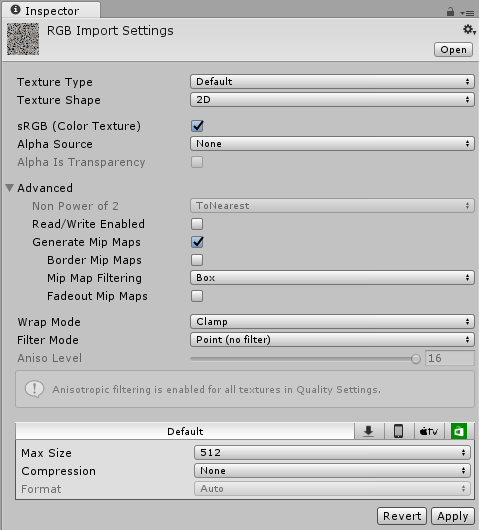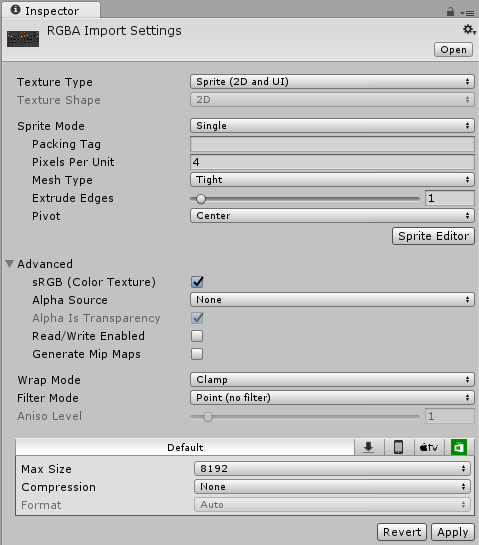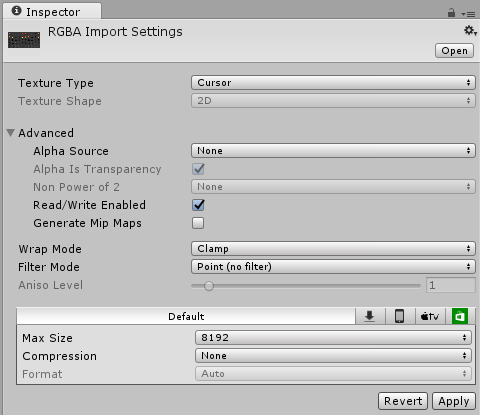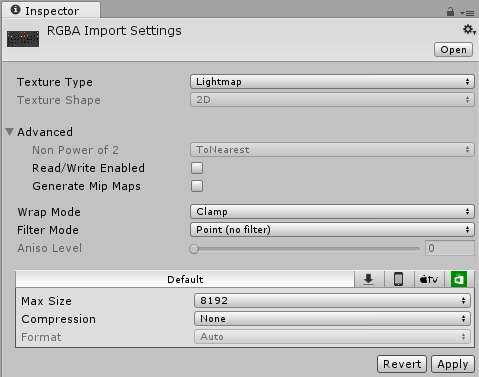Texture Types
You can import different Texture types into the Unity Editor via the Texture Importer.
Below are the properties available to configure the various Texture types in Unity in the Texture Inspector window. Scroll down or select from the list below to find details of the Texture type you wish to learn about.
For details on the Advanced settings and platform-specific settings, see documentation on the Texture Importer.
Texture type: Default

| Property: | Function: |
|---|---|
| Texture Type | Default is the most common setting used for all Textures. It provides access to most of the properties for Texture importing. |
| Texture Shape | Use this to define the shape of the Texture. See documentation on the Texture Importer for information on all Texture shapes. |
| sRGB (Color Texture) | Check this box to specify that the Texture is stored in gamma space. This should always be checked for non-HDR color Textures (such as Albedo and Specular Color). If the Texture stores information that has a specific meaning, and you need the exact values in the Shader (for example, the smoothness or the metalness), uncheck this box. This box is checked by default. |
| Alpha Source | Use this to specify how the alpha channel of the Texture is generated. This is set to None by default. |
| None | The imported Texture does not have an alpha channel, whether or not the input Texture has one. |
| Input Texture Alpha | This uses the alpha from the input Texture if a Texture is provided. |
| From Gray Scale | This generates the alpha from the mean (average) of the input Texture RGB values. |
| Alpha is Transparency | If the alpha channel you specify is Transparency, enable Alpha is Transparency to dilate the color and avoid filtering artifacts on the edges. |
Texture type: Normal Map

| Property: | Function: |
|---|---|
| Texture Type | Select Normal map to turn the color channels into a format suitable for real-time normal mapping. |
| Texture Shape | Use this to define the shape of the Texture. See documentation on the Texture Importer for information on all Texture shapes. |
| Create from Greyscale | This creates the Normal Map from a greyscale heightmap. Check this to enable it and enabled it and see the Bumpiness and Filtering. This option is unchecked by default. |
| Bumpiness | Control the amount of bumpiness. A low bumpiness value means that even sharp contrast in the heightmap is translated to gentle angles and bumps. A high value creates exaggerated bumps and very high-contrast lighting responses to the bumps. This option is only visible if Create from Greyscale is checked. |
| Filtering | Determine how the bumpiness is calculated: |
| Smooth | This generates Normal Maps with standard (forward differences) algorithms. |
| Sharp | Also known as a Sobel filter, this generates Normal Maps that are sharper than Standard. |
Texture type: Editor GUI and Legacy GUI

| Property: | Function: |
|---|---|
| Texture Type | Select Editor GUI and Legacy GUI if you are using the Texture on any HUD or GUI controls. |
| Texture Shape | Use this to define the shape of the Texture. See documentation on the Texture Importer for information on all Texture shapes. |
Texture type: Sprite (2D and UI)

| Property: | Function: |
|---|---|
| Texture Type | Select Sprite (2D and UI) if you are using the Texture in a 2D game as a Sprite. |
| Texture Shape | Use this to define the shape of the Texture. See documentation on the Texture Importer for information on all Texture shapes. |
| Sprite mode | Use this setting to specify how the the Sprite graphic is extracted from the image. The default for this option is Single. |
| Single | Use the Sprite image in isolation. |
| Multiple | Keep multiple related Sprites together in the same image (for example, animation frames or separate Sprite elements that belong to a single game character). |
| Packing Tag | Specify by name a Sprite atlas which you want to pack this Texture into. |
| Pixels Per Unit | The number of pixels of width/height in the Sprite image that correspond to one distance unit in world space. |
| Mesh Type | This defines the Mesh type that is generated for the Sprite. The default for this option is Tight. |
| Full Rect | This creates a quad to map the Sprite onto it. |
| Tight | This generates a Mesh based on pixel alpha value. The Mesh generated generally follows the shape of the Sprite. Note: Any Sprite that is smaller than 32x32 uses Full Rect, even when Tight is specified. |
| Extrude Edges | Use the slider to determine how much area to leave around the Sprite in the generated Mesh. |
| Pivot | The location in the image where the Sprite’s local coordinate system originates. Choose one of the pre-set options, or select Custom to set your own Pivot location. |
| Custom | Define the X and Y to set a custom Pivot location in the image. |
Texture type: Cursor

| Property: | Function: |
|---|---|
| Texture Type | Select Cursor if you are using the Texture as a custom cursor. |
| Texture Shape | Use this to define the shape of the Texture. See documentation on the Texture Importer for information on all Texture shapes. |
Texture type: Cookie

| Property: | Function: |
|---|---|
| Texture Type | Select Cookie to set your Texture up with the basic parameters used for the Cookies of your Scene’s Lights. |
| Texture Shape | Use this to define the shape of the Texture. See documentation on the Texture Importer for information on all Texture shapes. |
| Light Type | Define the type of Light that the Texture is applied to. Directional and Spotlight cookies must be 2D Textures, and Point Light Cookies must be cubemaps. The system automatically enforces the right shape depending on the Light type. For Directional Lights this Texture tiles, so in the Texture inspector set the Edge Mode to Repeat. For Spotlights, keep the edges of your Cookie Texture solid black to get the proper effect. In the Texture Inspector, set the Edge Mode to Clamp. |
| Alpha is Transparency | If the alpha channel you specify is Transparency, enable Alpha is Transparency to dilate the color and avoid filtering artifacts on the edges. |
Texture type: Lightmap

| Property: | Function: |
|---|---|
| Texture Type | Select Lightmap if you are using the Texture as a Lightmap. This option enables encoding into a specific format (RGBM or dLDR, depending on the platform) and a post-processing step on Texture data (a push-pull dilation pass). |
| Texture Shape | Use this to define the shape of the Texture. See documentation on the Texture Importer for information on all Texture shapes. |
Texture type: Single Channel

| Property: | Function: |
|---|---|
| Texture Type | Select Single Channel if you only need one channel in the Texture. |
| Texture Shape | Use this to define the shape of the Texture. See documentation on the Texture Importer for information on all Texture shapes. |
| Alpha Source | Use this to specify how the alpha channel of the Texture is generated. This is set to None by default. |
| None | The imported Texture does not have an alpha channel, whether or not the input Texture has one. |
| Input Texture Alpha | This uses the alpha from the input Texture if a Texture is provided. |
| From Gray Scale | This generates the alpha from the mean (average) of the input Texture RGB values. |
| Alpha is Transparency | If the alpha channel you specify is Transparency, enable Alpha is Transparency to dilate the color and avoid filtering artifacts on the edges. |
Copyright © 2023 Unity Technologies
优美缔软件(上海)有限公司 版权所有
"Unity"、Unity 徽标及其他 Unity 商标是 Unity Technologies 或其附属机构在美国及其他地区的商标或注册商标。其他名称或品牌是其各自所有者的商标。
公安部备案号:
31010902002961